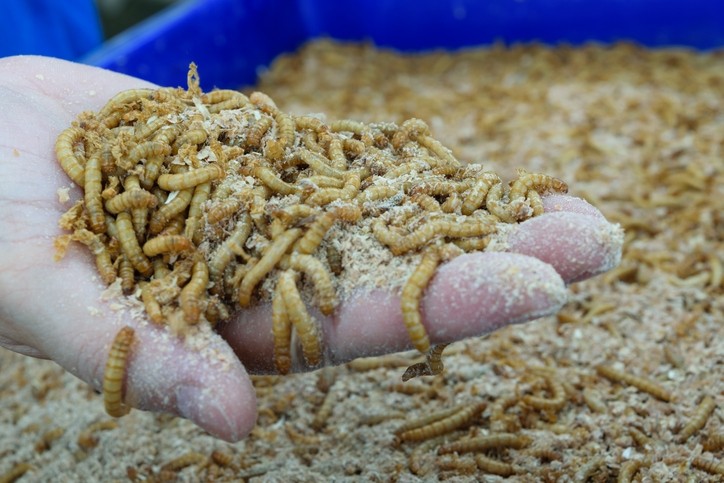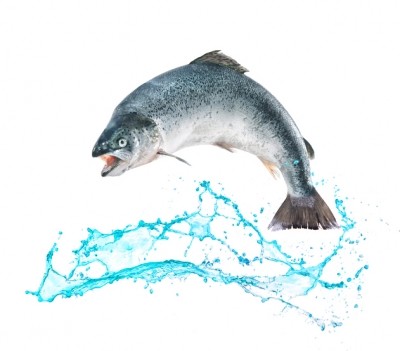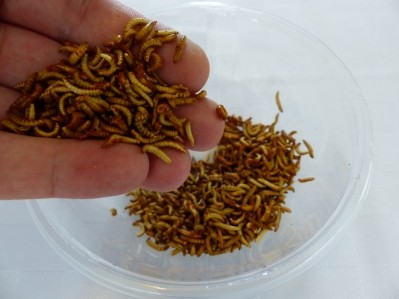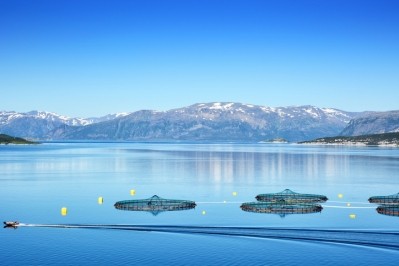Insect meal, oil show potential for partial fishmeal, oil replacement

An international team from Canada and the UK explored the use of different types of black soldier fly larvae (BSFL) ingredients – either larvae oil or defatted meal – on the production of rainbow trout. The group published its work in the journal Aquaculture.
“The objective of this study was to determine the effects of graded dietary inclusion levels of partially defatted BSFLM [black soldier fly larvae meal] and BSFLO [black soldier fly larvae oil] on growth performance, feed efficiency, nutrient digestibility and deposition, gut histology and blood biochemistry of rainbow trout,” the researchers said.
The research group found that growth was high for both sets of supplemented diets, except for fish getting the largest inclusion of black soldier fly larvae meal (BSFLM), the researchers said. Feed conversion ratios increased linearly and there was a negative correlation to body protein content as more BSFLM was added, although blood glucose levels fell as more black soldier fly larvae oil (BSFLO) was included.
“Based on these results, the maximum inclusion of BSFLM recommended in rainbow trout diets is 13%,” they said. “The maximum inclusion of BSFLO could potentially be superior to 10%, but this hypothesis needs further study.”
“The enhanced digestibility of hydroxyproline in diets containing BSFL products has potential benefits for fish fed low fishmeal diets,” they added.
Why black soldier fly ingredients?
The interest in finding sustainable alternatives to fishmeal and fish oil, has generated examinations of agricultural crops, animal by-products, microorganisms and insects, the researchers said. This work has included research and risk assessment studies examining the larvae of the black soldier fly for use as a feed ingredient for terrestrial and aquatic species.
Currently, most research with insects looks at the larval stage as a source of amino acids, lipids, proteins, fatty acids and functional molecules, they said. However, the variable biochemical composition of insect larvae can provide a challenge – BSFL meal can range from 40-54% or 15-49% on a dry matter basis.
“The processing of BSFL biomass into partially defatted protein-rich meal and oil fractions has become a frequent practice lately to minimize the variations in nutrient composition,” they said. “Furthermore, the reduction of lipid in BSFLM opens door to higher inclusion in feed mash processed through extrusion and attenuates the risk of lipid oxidation during storage.”
Studies looking at the use of defatted BSFLM have been run with turbot, pacific white shrimp, rainbow trout and Jian carp with a wide range of dietary inclusion levels, they said. Initial evaluations of BSFL oil were done with dietary levels below 3% and only for Jian carp.
“To our knowledge, the potential of BSFLO to replace fish oil in a growth study with consideration for nutrient utilization, gut histology and nutrient utilization remains to be assessed in aquatic species possessing lipid requirements higher than carp,” the researchers said.
Feeding trials
In the feeding trial, 630 juvenile rainbow trout were given one of seven diets for a period of three months, the researchers said.
The diets included a control (Diet A) with no BSFL ingredients, the basal diet with 6.6 (Diet B), 13.2 (Diet C) or 26.4% (Diet D) BSFLM, or the basal diet with 2.5 (Diet E), 5 (Diet F) or 10% (Diet G) BSFLO. The meal-based diets were formulated to replace 25, 50 and 100% of the fishmeal proteins in the control diet, while the oil-based diets replaced 25, 50 and 100% of the fish oil in the control diet.
The influence of the alternative ingredients on pellet quality was assessed for bulk density (BD) and sinking velocity (SV), they said. Fish were sampled to check weight, growth rate, feed conversion ratio (FCR) every 28 days, they said. Fish were checked for growth performance using the thermal-unit growth coefficient (TGC).
Fish tissue and blood samples also were collected and the hepatosomatic index (HSI) was established, they said. The proximate composition and overall amino acid content of fish tissue also were analyzed.
Additionally, the control diet from the growth trial was used to generate two additional diets including 80% of the reference diet and 20% defatted BSFLM (diet B-test) or 20% of BSFLO (C-test), said the researchers. These diets were used to check digestibility.
In the digestibility study, 180 juvenile trout were given one of the three diets for a week, after a conversion period to the new diets, they said. Fecal matter was collected and checked for composition, total amino acid content, and the apparent digestibility coefficient (ADC) was calculated.
Results
Growth performance, survival rate and feed conversion were high for both sets of trial diets, said the researchers. Growth was lowest for fish getting the diet with 26.4% BSFLM and there was a negative interaction between TGC and addition of BSFLM to the diet.
“BSFLM and BSFLO provided beneficial nutrients to rainbow trout based on the high growth performance and feed utilization observed at inclusion levels tested in this study,” they said. “Although results related to growth performance and feed utilization were positive and acceptable at all inclusion levels, BSFLM at dietary inclusion level ≥ 13% was somewhat challenging for trout to the point that whole-body protein and levels of several essential amino acids were depressed, and protein deposition as well as efficiencies of protein and lipid deposition were compromised significantly.”
Fish getting diet D had the highest HSI and there was a positive relationship between inclusion of BSFLM and HSI, they said. “Based on visual inspection, the liver and kidney of rainbow trout appeared normal in terms of color, shape and absence of apparent necrosis or other anomalies. Therefore, no histological examination was conducted for these tissues,” they added.
Feed color was not changed by the trial ingredients and bulk density remained similar, they said. Diets with BSFLO had better floatability than those including BSFLM.
“The whole-body crude protein and amino acid contents of rainbow trout was inversely correlated with dietary BSFLM inclusion level, but not BSFLO,” said the researchers. Hydroxyproline was the only nitrogenous compound that increased as the trial ingredients were used.
“BSFLM had a significant effect on gut histology only at 26.4% inclusion (Diet D) in the anterior intestine,” they said. There was no major influence seen from BSFLO on the width or length of villi.
“Glucose in trout fed BSFLM were not significantly different from the Control,” they said. “However, glucose of trout fed BSFLO at 2.5% inclusion was significantly higher than trout fed the Control or Diet G (10.0% inclusion). Plasma glucose was negatively correlated to BSFLO inclusion among the BSFLO-containing diets.”
In the second trial, digestibility of most nutrients was high and not altered by the trial ingredients, they said. However, digestibility of hydroxyproline was higher for fish getting the trial ingredients, while lipid digestibility was lower for trout getting the 20% BSFLM diet.
Source: Aquaculture
Title: The oil fraction and partially defatted meal of black soldier fly larvae (Hermetia illucens) affect differently growth performance, feed efficiency, nutrient deposition, blood glucose and lipid digestibility of rainbow trout (Oncorhynchus mykiss)
Authors: André Dumas, Thiago Raggi, Justin Barkhouse, Elizabeth Lewis, Erika Weltzien
DOI: doi.org/10.1016/j.aquaculture.2018.03.038















